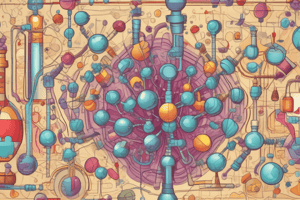Podcast
Questions and Answers
What does SAR stand for in medicinal chemistry?
What does SAR stand for in medicinal chemistry?
- Safety Assessment Report
- Standardized Assessment Review
- Structure Activity Relationship (correct)
- Systematic Analysis Result
What aspect of drug design focuses on understanding how drugs interact with receptors or enzymes in the body?
What aspect of drug design focuses on understanding how drugs interact with receptors or enzymes in the body?
- Mode of Action Analysis (correct)
- Toxicology Evaluation
- Pharmacogenomics
- Physicochemical Properties Study
Which process in medicinal chemistry involves predicting how a drug will act based on its behavior in the body?
Which process in medicinal chemistry involves predicting how a drug will act based on its behavior in the body?
- Pharmacokinetics (correct)
- Drug Screening
- Pharmacodynamics
- Drug Formulation
Which area of study in medicinal chemistry explores what happens to a drug when it enters the body?
Which area of study in medicinal chemistry explores what happens to a drug when it enters the body?
What is the primary focus of drug synthesis in medicinal chemistry?
What is the primary focus of drug synthesis in medicinal chemistry?
What is the main objective of drug design?
What is the main objective of drug design?
Which phase of drug design involves optimizing a lead compound for properties like potency and safety?
Which phase of drug design involves optimizing a lead compound for properties like potency and safety?
What techniques are commonly used during the discovery phase of drug design?
What techniques are commonly used during the discovery phase of drug design?
What is the primary focus of preclinical testing in drug development?
What is the primary focus of preclinical testing in drug development?
Which phase of clinical trials involves testing the drug on healthy volunteers?
Which phase of clinical trials involves testing the drug on healthy volunteers?
What is the last stage in drug design where post-marketing surveillance is conducted?
What is the last stage in drug design where post-marketing surveillance is conducted?
What is the purpose of patent protections in the context of new drug designs?
What is the purpose of patent protections in the context of new drug designs?
What role do patents play in protecting intellectual property rights related to drug designs?
What role do patents play in protecting intellectual property rights related to drug designs?
What are some challenges faced in drug design according to the text?
What are some challenges faced in drug design according to the text?
How do patents incentivize companies in the context of drug design?
How do patents incentivize companies in the context of drug design?
What is the significance of regulatory approval in the process of drug commercialization?
What is the significance of regulatory approval in the process of drug commercialization?
What opportunities arise from the challenges faced in drug design according to the text?
What opportunities arise from the challenges faced in drug design according to the text?
Flashcards are hidden until you start studying
Study Notes
Medicinal Chemistry
- Medicinal chemists study drug synthesis, Structure-Activity Relationship (SAR), Absorption, Distribution, Metabolism, and Excretion (ADME), and mechanism of action
- They design and make new drug compounds and examine how small changes to a molecule affect its biological activity
- They investigate how a drug is absorbed, distributed, metabolized, and excreted in the body to predict its effects
Commercialization
- A drug that proves effective and safe may receive regulatory approval and move onto market authorization
- Companies then manufacture, package, and distribute the drug globally
- Patent protections grant inventors exclusive rights to their invention for a specified period, typically 20 years from the filing date
- This provides incentive for companies to invest in research and development of innovative drugs
Challenges and Opportunities
- Despite advancements in drug design, challenges remain, including understanding complex biology systems, dealing with scientific uncertainty, and ensuring drug quality
- These challenges present opportunities for innovation, collaboration, and groundbreaking developments in understanding diseases and treatments
- They include predicting human response, managing costs, addressing safety concerns, overcoming resistance, promoting accessibility, and navigating ethical issues
Drug Design
- Drug design involves discovering, designing, developing, and commercializing pharmaceutical drugs
- It requires a multidisciplinary approach to develop new medicines and treatments for diseases
Discovery
- The discovery phase focuses on identifying promising compounds that interact with biological targets such as proteins, enzymes, and receptors involved in disease processes
- Techniques like high-throughput screening, molecular modeling, and bioinformatics help identify potential candidates from large libraries of chemicals
Design
- Once a lead compound is identified, it undergoes optimization to improve its properties, such as potency, selectivity, safety, and stability
- This process involves iterative cycles of structural modification and property evaluation until an acceptable candidate emerges
Development
- The selected compound undergoes preclinical testing to evaluate toxicity, efficacy, and dosage regimen
- If successful, the drug enters clinical trials to assess safety and effectiveness in volunteers or patients
- Clinical trials involve increasing numbers of participants across phases, ranging from Phase I (healthy volunteers) to Phase IV (post-marketing surveillance)
Studying That Suits You
Use AI to generate personalized quizzes and flashcards to suit your learning preferences.




